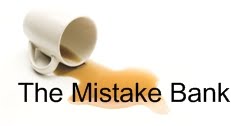Apple's CEO, Tim Cook, posted the above letter to the Apple website last week, responding to a week of controversy over the iPhone's Maps application. Apple Maps, replacing a Google-developed app, was praised for its beautiful design and Flyover feature, but vilified for its geographic errors. David Pogue, the New York Times tech columnist,
wrote of Maps, "It may be the most embarrassing, least usable piece of software Apple has ever unleashed."
Some commentators are already toting up the damage from the Maps mistake - very premature in my view. I'd prefer to look at Apple's actions regarding the situation using the framework from my 99u piece ("
How to Bounce Back From a Big Mistake"), which will form part of the upcoming Mistake Bank book. Here are the main steps involved in bouncing back:
1. Own Your Mistake
To their credit, Apple did not blame its users, or the tech press (which could have been accused fairly of piling on). The company is living with the consequences.
2. Fix it, and Make Sure Others Are Aware
There was no need to make sure people are aware of the Maps issue; it became worldwide news. As far as fixing the mistake, Apple cannot fix it immediately. It will take months if not years of updating. Cook is to be credited for advertising competitive solutions (including Google's) as replacements for Maps v1.
3. Apologize
The letter is a nice example of a legitimate apology. If you don't think that's difficult, check out former
US Press Secretary Ron Ziegler's attempt.
4/5/6. Reflect, decide what you'll do differently in the future and share that knowledge
It's too early for these steps to be taken yet, but I would hope that Apple learns as much as they can from this episode and puts it to use. There's a lot we don't know, including whether Apple was essentially forced to rush out its own Maps because of actions by Google to withhold access to its own app, or to starve the iPhone app of features to favor its own Android platform. I can tell you from experience that ending significant partnerships often creates havoc with products and customers.
At any rate, you'd expect a company like Apple to mine this big time - possibly to redouble their efforts to control their own destiny with key iPhone features.
What do you think Apple should learn from the Maps mistake?




